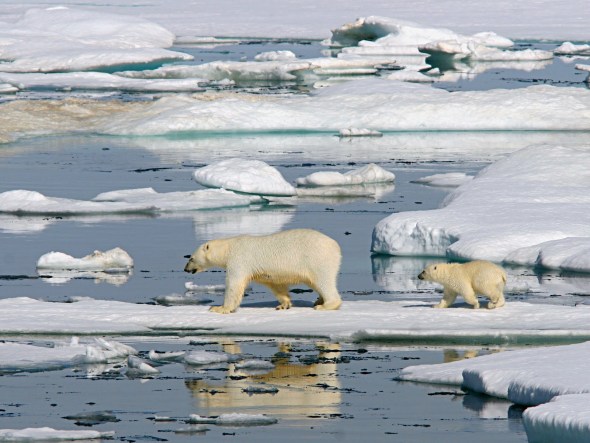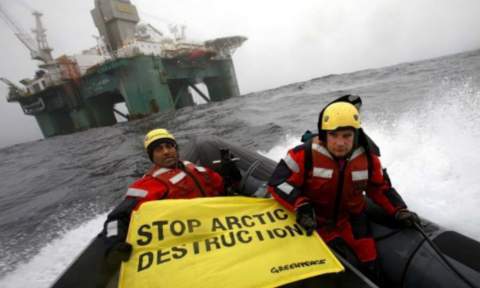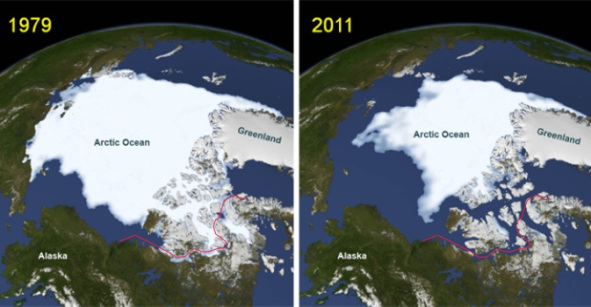ARCTIC MELTDOWN - WE MUST NOW ADAPT OR DIE
Climate change is now the number one destroyer of our planet that is affecting human, vertebra, invertebrates, mammals and our ever changing botanical ecosphere. Known as “global warming” one cannot state that the government is the number one factor causing our planet to disintegrate, changing the way human and non-human life lives to killing of many delicate species of plant, trees and lichens the first ever recorded breathing species of plant life to live on the face of the earth.
One can no longer place blame upon the government for this or environmental agencies as the warning messages have been sent global on a yearly basis to every corner of the earth. Although the government is a number two contributor to the earth’s climate now changing rapidly and without any warning what so ever we the human living race are the number one factor that has destroyed our fragile ecosphere, ozone, to the air we breathe.
Scientists, meteorologists, seismologists, environmentalists to botanists and marine biologists have all been working together to inform us of this extremely important fundamental change to our society, yet we as humans the very people that are supposed to take this on board are just merely ignoring this data, and many warning messages that have been published via the radio, satellite television, to booklets and friends of the earth such as Greenpeace and other activists have just gone on un-heard.
We are now then left in a sticky predicament though as it’s no longer about how does one change these problems but more how does one now adapt to the irreversible damage that we have placed ourselves, animals and plant life in to.
Arctic meltdown has now started to progress rapidly of which planet earth faces it biggest change in three million years. The term “Melt Smash and Grab” has been used for Shells push to now open up the Arctic Ocean, although this is not going to plan of which Shell the petroleum giant has already scaled back its plans. Shells plans to cause more catastrophic damage to the earth have been prevented in the Beaufort Sea this year 2012 due to whaling taking priority. With the Artic sea ice at its lowest for at least three million years then the rush to exploit hitherto inaccessible resources-principally oil, fish and minerals is well and truly on. Environmental disaster for many of the world’s inhabitants, to say nothing of its flora and fauna but for some people it is simply a commercial opportunity.
The interest groups vying for the Arctic’s wealth are likely to intersect in unprecedented ways. Shells deferral to native Alaskans (Pic Below), whose traditional hunting season it is obliged to respect, it is a portent of esoteric clashes to come of which International Animal Rescue Foundation are not looking forward to.
The melting of the Arctic ice has long been forecast to many humans that have simply just turned their head as if to say, “it’s not going to happen to me” now though sadly and regrettably scientists, meteorologists, environmentalists’ and activists of the earth are now stating in the clearest possible language that climate change is now upon us, and unfortunately it’s not going to get any better.
Now that the melting of the ice cap is “well under way” of which is rapid and highly unpredictable it is going to hit is with much force and vengeance the less predictable consequences of humanity’s impact on the climate will soon become more clearer in the “years to come” instead of what was normally quoted centuries to come “if human man, woman and child” did not change their destructive ways and manners. International Animal Rescue Foundation welcomes all of its supporters and readers, to those that have fallen upon our page to the age of GLOBAL WARMNG.
HUMAN BEHAVIOUR IS TO BLAME
In the context of climate variation, anthropogenic factors are human activities which affect the climate. The scientific consensus on climate change is “that climate is changing and that these changes are in large part caused by human activities and it “is largely irreversible.”
Of most concern in these anthropogenic factors is the increase in CO2 levels due to emissions from fossil fuel combustion, followed by aerosols (particulate matter in the atmosphere) and cement manufacture. Other factors, including land use, ozone depletion, animal agriculture and deforestation, are also of concern in the roles they play - both separately and in conjunction with other factors - in affecting climate, microclimate, and measures of climate variables.
Climate change in the recent past may be detected by corresponding changes in settlement and agricultural patterns. Archaeological evidence, oral history and historical documents can offer insights into past changes in the climate. Climate change effects have been linked to the collapse of various civilizations.

A world glacier inventory has been compiled since the 1970s, initially based mainly on aerial photographs and maps but now relying more on satellites. This compilation tracks more than 100,000 glaciers covering a total area of approximately 240,000 km2, and preliminary estimates indicate that the remaining ice cover is around 445,000 km2. The World Glacier Monitoring Service collects data annually on glacier retreat and glacier mass balance From this data, glaciers worldwide have been found to be shrinking significantly, with strong glacier retreats in the 1940s, stable or growing conditions during the 1920s and 1970s, and again retreating from the mid-1980s to present.
Geophysical Research Abstracts
Vol. 14, EGU2012-8304, 2012
EGU General Assembly 2012
© Author(s) 2012
The current DE glaciation of the Ortles-Cevedale massif (Eastern Italian
Alps): impacts, controls and degree of imbalance
L. Carturan (1), R. Filippi (2), R. Seppi (3), P. Gabrielli (4), C. Notarnicola (2), L. Bertoldi (5), F. Paul (6), P.
Rastner (6), F. Cazorzi (7), and G. Dalla Fontana (1)
(1) Department of Land, Environment, Agriculture and Forestry, University of Padova, Italy ([email protected]), (2)
Institute for Applied Remote Sensing, EURAC, Bolzano, Italy, (3) Department of Earth and Environmental Sciences, University of Pavia, Italy, (4) Byrd Polar Research Centre and School of Earth Science, The Ohio State University, Columbus, Ohio, USA, (5) Chartagena, aerial analysis, Trento, Italy, (6) Department of Geography, University of Zurich, Switzerland, (7)
Department of Agriculture and Environmental Sciences, University of Udine, Italy
The Ortles-Cevedale is the largest glacierzed mountain group of the Italian Alps hosting 112 ice bodies, with a total area of 76.8 km2. Since the 1980’s, this massif is undergoing a rapid DE glaciation, as most of the mountain ranges in the European Alps. The aims of this work were: i) to quantify area and volume change of the Ortles- Cevedale glacier system from the 1980s to the 2000s; ii) to improve the knowledge of factors controlling the spatial variability of the DE glaciation; and iii) to assess the degree of imbalance of individual glaciers with respect to the present climate conditions.
Two inventories were created, based on Landsat5 TM scenes of 20-09-1987 and 31-08-2009. Contrast-enhanced composites (bands TM5, TM4 and TM3), aerial photos and field surveys (for the most recent period) were used to correct the automatic delineation of glaciers derived from a hard classification based on a threshold applied to a TM3/TM5 ratio image. Since Landsat scenes were acquired at the end of the ablation seasons and fresh snow was absent, the accumulation areas could be roughly determined by mapping the snow covered area. This region was identified from the difference in reflectance between snow and ice in the near infrared band of Landsat (TM4), and mapped after correcting topographic effects to determine surface reflectance. The area-averaged geodetic mass budget was then calculated for the individual glaciers by differencing two Digital Terrain Models (2000s minus 1980s, derived from LiDAR and aerial photogrammetry) and combining the result with the glacier outlines. Afterwards, we examined the mass balance data using statistical analyses (Correlation matrices, Principal Component Analysis, Cluster Analysis). This allowed us highlighting clusters of glaciers, which exhibit a similar behaviour, identify the out layers and the relative influence of the factors controlling spatial variability of the mass losses.
Finally, we assessed the degree of imbalance of individual glaciers by comparing the current Accumulation Area Ratios (AAR) with the balanced-budget AAR (AAR0), the latter also accounting for the debris cover of glaciers. We found that the total area loss of the Ortles-Cevedale glaciers from 1987 to 2009 amounts to 23.5 km2, i.e. 23.4% of the initial area. On the other hand, the AAR of the entire glacier system was 0.3 in both investigated years. The overall debris cover increased from 10.5% to 16.3%. The geodetic mass balance rate was -0.7 m w.e. y1(as an average on 112 ice bodies), ranging from -0.1 to -1.7 m w.e. y1. We also found that the main controls of the differing change of single glaciers are related to their hypsometry (elevation range and slope), AAR, feeding source and debris cover. Interestingly, a significant correlation was found between AAR, AAR0 and debris cover.
This information was used to assess and visualize the needed additional reduction of individual glaciers to reach equilibrium with the current size of their accumulation areas. This amounts on average to a further reduction of
The information above may seem a little eye boggling to some, but what it is actually explaining though through in-depth and thorough investigations is that we need not be just worried about the Arctic melting away causing high sea levels, high river levels, in-land floods causing devastating damage but more hoe global warming “climate change” is effecting us more in land and well away from the Artic. I am sure that anyone that lives near the Italian Alps or frequents the Alps on holidays would now notice that there has been a significant change in land snow mass reducing slowly but surely and air temperature rising plus more
This is not the only major concern though and that was and has made headline news with all environmental agencies including ourselves International Animal Rescue Foundation from an in-depth study carried out this August 2012 of which showed some horrifying and frightening environmental data received to date by many scientists.
Not only do we have a major problem on now our own doorstep but the Artic in the most basic terminology is now in destruct mode that is going to have a disastrous effect on the selfish and destructive human race to-date.
Climate change has had more of an impact on the Arctic ice than any other place on earth. International Animal Rescue Foundation can now publish this report that other experts in the field have reported and published to as of now an “up to data analysis” but most saddening destruction of our earth that we can no longer stop but adapt to.
Air temperatures’ are rising twice as fast as the global average and models predict that the region will see temperatures’ rise by between a 6oc and alarming 14oc by 2010 of which there will be no more ice caps left thus meaning we are going to see sea bound costal homes under water, marshes gone, wildlife habitat completely wiped out, rivers and levies breaking thus causing millions of Euros/dollars of damage, more prominent countries that are islands such as the United Kingdom and Ireland being hit hard with major flooding with an enormous amount of life loss, animal loss, and financial damage from which many insurance institutions have not even bothered to assess, and building companies to home buyers moving closer to the rivers edges or on “flood plains” that we HIGLHY ADVISE you stay well clear of as of immediate effect.
Less ice in the Artic means more light enters the ocean beneath, fuelling more life, BUT it also means warmer surface waters and more energy released into the atmosphere. That energy drives cyclones, which then generates massive mammoth waves capable of ripping in the ice pack degrading it further. The consequences are not good for this highly specialised environment and the knock on effects for the rest of us is not a case of “can but WILL” be severe.
The picture above shows the graphic loss of ice from 1979-2011,
(ARE WE MAKING A POINT HERE)?
It may not see much to you bu infact it is, and by far thousands of tons of ICE hav melted away, 2050 will see no ice. THAT IS FACT…. 2020 will see a vast extent of our Asian rainforests gone to.
(Floods like these above will become the norm unless action is taken to not stop them BUT DEFEND your homes)
More startling data and very worrying that we have received is that of the thickness of the ice which again is telling us and other environmentalists that we are heading for a massive surge in weather and other environmental changes. From 1979-2000 the average volume of Arctic ice in September was 12,000 cubic kilometres, this year as of August 27th 2012, 3,000 cubic kilometres, so in plain basic and as simple words as one can state we are three quarters of the way to a summertime ice-free Arctic ocean with all the climatic, geopolitical, environmental and massive economic consequences.
On the 27th August 2012 it was reported using the most accurate data and instruments, surveys and land coverage census of the area in which we have lost as follows. Artic sea ice coverage fell to roughly 4.1 million kilometres, the lowest since satellite records began in 1979, it will shrink for a few more weeks before growing again the summer. The long term trends are damning, the latest climate models predict that by around 2050 (30 years after 80% of all rain forests are gone in Indonesia and Malaysia) the Artic will be completely ice free during the Summers when that happens the Artic routine stable for millions of years will be flipped on to its head. The changes that human life will see will be the worst since human civilisation began.
So who is to blame for all of this? We are. Not just the government we all as a human civilisation are all to blame for this major and nearing environmental event that will not only wipe out life but also vast sized areas of land to even small islands as of human negligence.
Its no longer of a case a WHEN but HOW SOON..
REDUCE
REUSE
RECYCLE
International Animal Rescue Foundation







Thank you for your reply, should it merit a response we will respond in due course. This site is owned by International Animal Rescue Foundation and moderation is used.